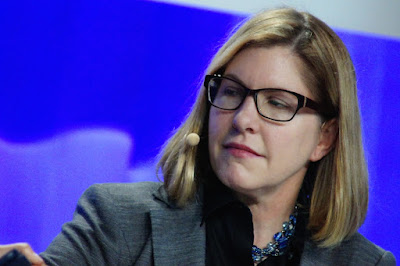Lighting array in the Hyatt Regency lobby. It just looked cool.
They always close the conference with "Launch!" day, with ten startups announcing and demonstrating their new products, after which attendees vote on their favorite. Unfortunately for me, this session ran behind schedule and I had to leave for my daily RadOnco tx mid-way through the demos. Then I hit heavy traffic on the 680 both east of Fremont and again around Alamo. I made some of it up by doing 80 in the HOV lane (which was pretty much the velocity in that lane anyway), and got to the Pleasant Hill clinic only about 15 minutes late. A stressful day. You have to show up with an empty digestive tract all the way down and a full bladder (30 oz). So, just a couple of cups of coffee and nothing at all to eat all day until after tx. I finally got home about 4:30, famished. Back on normal schedule today, Calypso tx at 10:30 a.m. I'll be 51% done after today (23 of 45 sessions). "Nuke The Donald."
For now, some shots. I'll have more observations later.
Hmmm... Too much single, static POV in my shots. Back during my Vegas "20 Feet from Stardom" photographer days I had free run of the stages, and I worked every angle (I usually dressed in black to minimize drawing distractive attention to myself). Here, though, I feel a bit self-conscious, not wanting to draw audience attention from the stage. So, I typically plop down in whatever close-up seat is available and rarely roam.
Below, HealthLeadersMedia's Scott Mace moderates the AMA Deep Dive panel discussion. This was one of my favs.
 |
| AMA CEO James Madara |
 |
| AMA Group VP Michael Tutty |
A few more random shots for now.
OK, this was cool. One of the Launch! presentations. Bloom Life smartphone app for fetal monitoring.
Truly a "live" demo.
BTW, one thing that's been bugging me, and something that Matthew Holt alluded to during his presentation with Michael Millenson.
— Bobby Gladd (@BobbyGvegas) October 8, 2015
A medical device is "an instrument, apparatus, implement, machine, contrivance, implant, in vitro reagent, or other similar or related article, including a component part, or accessory which is: ... intended for use in the diagnosis of disease or other conditions, or in the cure, mitigation, treatment, or prevention of disease, in man or other animals..."The HIT haters out on the blog commentaries have long angrily railed against EMRs/EHRs as "untested, unregulated, dangerous medical devices," notwithstanding that the FDA long ago specifically disavowed regulatory jurisdiction over them. Now, with this wild, wild west proliferation of all manner of health monitoring and dx apps like those we see at Health 2.0, what of "regulation"?
BTW, the other 2015 Launch! presenters:
I got to see maybe seven presentations before having to bail. All very interesting. All very niche. No digital health Swiss Army Knives here -- which, of course, I know, would be asking way too much.
SPEAKING OF EHRs
Dr. Jerome Carter's latest at EHR Science:
Clinician Productivity after EHR Implementation—We’re Measuring it Incorrectly.Always excellent.
by JEROME CARTER on OCTOBER 5, 2015
Pre/post-implementation studies typically use a few standard measures. Business metrics (e.g., total cost of ownership, return on investment, revenue changes) and clinical metrics (e.g., patient visit levels, visit duration) are employed to get an understanding of how the EHR’s presence has impacted the organization (1,2,3). Unfortunately, clinical metrics often assess the post-implementation state from too high a level to detect actual changes in clinician productivity. As a result, they do not convey the underlying reality that clinicians experience.
Dimensions of clinical work
Clinical work does not require the presence of a patient. If we define clinical work as “any activity undertaken by a clinician to support the diagnosis and management of patients,” then clinical work often occurs outside of patient encounters.
Results management is a huge part of patient care. I used to spend at least an hour each day reviewing results and planning future interventions. This work was done at my desk, usually after hours. When results were expected and the proper follow up already in the works (i.e., patient has elevated liver enzymes, but presented with signs of hepatitis) life was good. However, there were many times when a change in therapy was required or a diagnostic workup plan was altered by unexpected results. A new breast mass, unexpected liver enzyme elevations, a call from a patient, or my personal favorite, microscopic hematuria, could easily result in chart reviews, literature searches, or calls to a colleagues. This is clinical work, and current post-implementation metrics do not measure it.
Care coordination is another activity that can occur outside of patient encounters. One of the few times I had a terminal patient in hospice care required many phones calls to family and discussions about pain management. The notes were in the patient’s record, but the work was done outside of any visit.
Complaints related to documentation completion also fail to show in EHR productivity metrics. Completing documentation after patients have left is doing clinical work, but it is not counted...
___
More to come...



















No comments:
Post a Comment